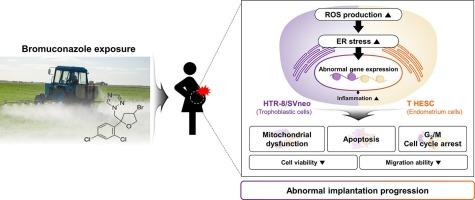Bromuconazole impairs implantation process through cellular stress response in human trophoblast and endometrial cells
IF 4
1区 农林科学
Q2 BIOCHEMISTRY & MOLECULAR BIOLOGY
引用次数: 0
Abstract
Bromuconazole, a widely used triazole-based pesticide, effectively controls fungal diseases in agriculture. Bromuconazole cause a potential toxic effect to non-target organisms and can have a negative impact on reproductive health in women, due to its long half-life and bioaccumulation ability. This study identifies the cytotoxicity and adverse effects of bromuconazole on trophoblastic cells (HTR-8/SVneo) and human endometrial cells (T HESCs), which are involved in implantation processes. The results of this study showed that 48 h of exposure to bromuconazole inhibited the viability of HTR-8/SVneo and T HESCs, and the LC50 values of each cell were identified as 28.05 mg/L and 33.41 mg/L, respectively. To identify the intracellular mechanisms of cytotoxic effects, subsequent in vitro experiments were performed after bromuconazole exposure at ≤30 mg/L concentration. 30 mg/L bromuconazole significantly induced apoptosis and cell cycle arrest after 48 h exposure through regulate the mRNA level of related factors. Bromuconazole increased reactive oxygen species accumulation and endoplasmic reticulum stress, and dysregulated MAPK (p-ERK and p-JNK) signaling. Finally, bromuconazole disrupted mitochondrial function, induced inflammation, and inhibited cell migration. These results indicate the need for more stringent regulation of the use of bromuconazole and further in vivo studies of its reproductive toxicity. This study is the first to suggest that bromuconazole adversely affect the implantation process and female reproduction.

溴康唑通过人滋养细胞和子宫内膜细胞的细胞应激反应损害着床过程
溴康唑是一种广泛使用的三唑类农药,可有效防治农业真菌病害。溴康唑对非目标生物有潜在的毒性作用,由于其半衰期长和生物蓄积能力,可对妇女的生殖健康产生负面影响。本研究确定了溴康唑对植入过程中涉及的滋养细胞(HTR-8/SVneo)和人子宫内膜细胞(T HESCs)的细胞毒性和不良反应。本研究结果显示,暴露于溴康唑48 h后,HTR-8/SVneo和T HESCs的活力均受到抑制,每个细胞的LC50分别为28.05 mg/L和33.41 mg/L。为了确定细胞毒性作用的细胞内机制,在≤30 mg/L浓度的溴康唑暴露后进行了后续的体外实验。30mg /L溴康唑通过调控相关因子mRNA水平,显著诱导48 h后细胞凋亡和细胞周期阻滞。溴康唑增加活性氧积累和内质网应激,并失调MAPK (p-ERK和p-JNK)信号。最后,溴康唑破坏线粒体功能,诱导炎症,抑制细胞迁移。这些结果表明,需要对溴康唑的使用进行更严格的监管,并进一步对其生殖毒性进行体内研究。本研究首次提出溴康唑对着床过程和雌性生殖有不良影响。
本文章由计算机程序翻译,如有差异,请以英文原文为准。
求助全文
约1分钟内获得全文
求助全文
来源期刊
CiteScore
7.00
自引率
8.50%
发文量
238
审稿时长
4.2 months
期刊介绍:
Pesticide Biochemistry and Physiology publishes original scientific articles pertaining to the mode of action of plant protection agents such as insecticides, fungicides, herbicides, and similar compounds, including nonlethal pest control agents, biosynthesis of pheromones, hormones, and plant resistance agents. Manuscripts may include a biochemical, physiological, or molecular study for an understanding of comparative toxicology or selective toxicity of both target and nontarget organisms. Particular interest will be given to studies on the molecular biology of pest control, toxicology, and pesticide resistance.
Research Areas Emphasized Include the Biochemistry and Physiology of:
• Comparative toxicity
• Mode of action
• Pathophysiology
• Plant growth regulators
• Resistance
• Other effects of pesticides on both parasites and hosts.

 求助内容:
求助内容: 应助结果提醒方式:
应助结果提醒方式:


